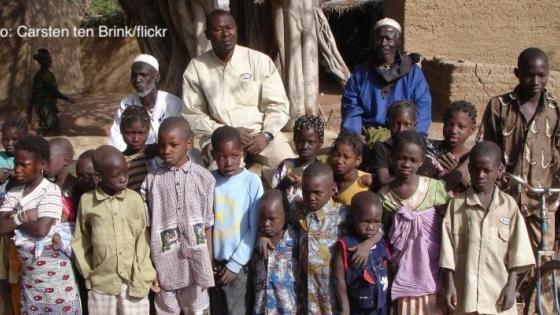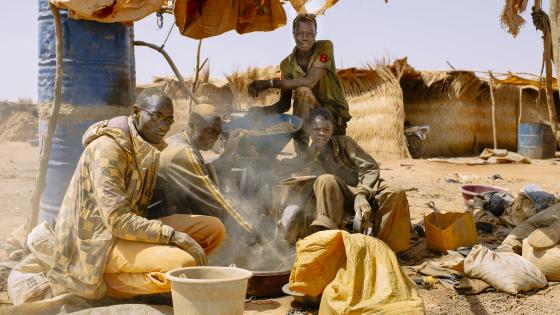Adherents to the culturalist approach to anthropology believe that household organisations are based on norms reflecting local cultures and that they are therefore likely to vary substantially between regions. This is epitomised by comparing the large, horizontally and vertically extended households of sub-Saharan Africa to the nuclear families of Eurasia. Family norms may nevertheless respond to changes in the economic-demographic environment, which is the basis of the intuition that guided Danish economist Ester Boserup (1965). In Boserup’s work, technical change is understood to promote farm and household division: the rise of small peasant farms results from growing land scarcity and the consequent intensification of agricultural techniques.
Her detailed argument is easily translated in the terminology favoured by economists (Binswanger and Rosenzweig 1986, Binswanger and McIntire 1987, Binswanger et al. 1989). As land pressure increases, farmers are induced to shift to more intensive forms of land use, for which they adopt increasingly land-saving and labour-using techniques. These techniques rely heavily on labour quality, which is costly to monitor. Given the incentive problems associated with care-intensive activities, small family or peasant farms, in which a few co-workers (spouses and their children) are residual claimants, appear to be the most efficient farm structure.
If we follow Boserup’s argument, we should see a gradual convergence between farm-cum-household forms as population growth and market integration put increasing pressure on the land. Indeed, a cursory glance at sub-Saharan Africa reveals that extended families are found across large parts of the continent but are notably absent in a few places exhibiting characteristically high population densities: Rwanda, Burundi, the Lake Victoria region in Kenya, and Malawi. In these areas, the small family farm based on parents and children prevails, as it does in Europe and Asia.
Economists have recently addressed this issue (see Guirkinger and Platteau, 2017, 2019).1 Foster and Rosenzweig (2002), for instance, analyse the decision of family members to stay together or split the household into independent units. Co-residence gains arise from consuming household public goods and sharing information regarding farming techniques. Offsetting these gains, some members have a preference for autarchic residency and may differ in their preferences for the public good. This trade-off makes it impossible to offer a general prediction about whether technical progress increases or decreases the likelihood of splits. If technical change deepens within-household differences in autarchic incomes (due to differences in schooling), leading to greater conflicts over the level of public good, it may simultaneously enlarge the opportunities for information sharing inside the household while also raising the demand for the household public good (as incomes increase). While the former factor encourages division, the latter has the opposite effect, making the total effect of technical change on household division unclear. Using Indian data, Foster and Rosenzweig found a complex pattern: the effect of increased agricultural technical change on division goes in opposite directions for large and small farming households: while the probability of division is strongly reduced for the former, it is barely affected for the latter. This suggests that the gains associated with returns to information sharing and increased demand for the public good predominates when rates of technical change are high, but only for sufficiently large farms.
We propose a different theory, whereby household and farm division may occur even in the absence of technical progress, as a result of land scarcity or market integration (Guirkinger and Platteau 2015). Unlike Foster and Rosenzweig, we posit a patriarchal framework in which the head of the farm-cum-family is the ultimate decision-maker. In addition, we look at the effects of land scarcity and market integration on two forms of individualisation: splits of complex households into nuclear households, and the awarding of private plots to members of a complex household inside a mixed farm organisation (where private plots coexist with the collective, family field). Because the rapid spread of private plots does not end the practice of common kitchens and collective meals, it cannot be caused by the diminishing value of joint consumption (at least in the context of West Africa).
The patriarch maximises the income he obtains from the collective field under the constraint that the (adult) members of the household earn a minimum (reservation) income determined by the wage-labour market. He chooses the share of the collective output that he keeps for himself, the size of the individual plots allotted to members (which can be set at zero), and the number of male adults staying on the paternal farm. Members observe these choices and individually decide how to allocate effort between the two types of plots. They act non-cooperatively because they are unable to enforce binding agreements prescribing individual efforts on the collective field.
Since the patriarch acts selfishly, a trade-off arises between efficiency and rent-capture considerations. When deciding whether and how much to give of his private plots, he weighs two factors. First, production is more efficient on private plots than on the collective plot where cultivation is plagued by the free-riding problem. Awarding individual plots allows the patriarch to more easily ensure that family members stay on the family farm instead of choosing an outside option. Second, because his income comes entirely from the collective output (transfers from private plots are empirically insignificant and hence ignored in this theory), competition for the allocation of work effort by the members reduces his income. If transfers from private plots were feasible, he would earmark the whole of his family land for private use by members and maximize efficiency.
The patriarch also decides whether to maintain the family and the farm whole (with or without private plots), or to allow a split of the joint household and a concomitant division of the family land. Since the number of (male) members authorised to leave may vary, the extent of the split itself must be chosen. In the case of a pre-mortem split, the total labour force available for work on the collective field decreases, which harms the patriarch, but makes it no more incumbent on him to provide for the needs of the departed members, which works to his advantage. Depending on the relative importance of these effects, he may prefer a mixed regime with private plots to the collective regime, or he may choose to split the family.
As land pressure increases, or when outside opportunities improve for members, the agricultural household evolves, growing more individualised. In response, the patriarch may decide to transform a collective farm into a mixed farm or into smaller independent units. The initial organisational form is always the collective farm, which is optimal when land is sufficiently abundant (or outside opportunities sufficiently low). Which individualised form will succeed the collective is a complex issue, since possibilities abound depending on the number of (male) members authorised to leave, and whether private plots are granted to the remaining members when some have left with a portion of the family land.
In Figure 1, we depict the succession of organisational household forms as land scarcity and outside opportunities increase (results obtained through simulation).
Figure 1 Partition of the land endowment–reservation utility space into regimes
Increasing land scarcity at the household level and/or improved outside options also reduces social inefficiency inside the farm and the household. In other words, rent capture by the patriarch is increasingly constrained in these conditions. The pressure to increasingly individualise both farm and household is the operating mechanism.
On the basis of data collected in Mali (Guirkinger and Platteau 2014, Guirkinger et al. 2015), we show that private plots are more likely to be found when the land endowment of a farm is smaller, and the causality works in the direction pointed by the theory. Furthermore, and again according to theory, productivity per unit of land is higher on private plots than on the collective field, and this advantage stems from application of greater efforts. Unfortunately, the data do not allow us to rigorously explore the determinants of household division. Still, the theory provides a useful explanation for the fact that division is increasingly observed in technically stagnant areas of West Africa where land pressure has increased.
Finally, Bardhan et al. (2014) created a model that bears some similarity to the above. They assume that free riding plagues production on the collective field (a problem somewhat mitigated by imperfect altruism). On the other hand, while an active labour market exists (and possibly an active land market as well), patriarchy does not. In short, growing land scarcity encourages household splits while technical progress of the land-augmenting type has the opposite effect, encouraging farm consolidation. A key implication of this work in its entirety is this: to accurately assess the impact of land pressure and technical change on inequality, it is essential to take household splits into account. Ignoring them will yield misleading conclusions.
References
Bardhan, P, M Luca, D Mookherjee and F Pino (2014), “Evolution of Land Distribution in West Bengal 1967–2004: Role of Land Reform and Demographic Changes”, Journal of Development Economics, 110:171-190.
Foster, A and M Rosenzweig (2002), “Household Division and Rural Economic Growth”, Review of Economic Studies, 69: 839-869.
Binswanger, H and M. Rosenzweig (1986), “Behavioral and Material Determinants of Production Relations in Agriculture”, Journal of Development Studies, 22(3): 503-539.
Binswanger, H and J McIntire (1987), “Behavioral and Material Determinants of Production Relations in Land-Abundant Tropical Agriculture”, Economic Development and Cultural Change, 36(1): 73-99.
Binswanger, H, J McIntire and C Udry (1989), “Production Relations in Semi-Arid African Agriculture”, in Bardhan, P (ed), The Economic Theory of Agrarian Institutions, Oxford: Clarendon Press: 122-144.
Guirkinger, C and JP Platteau (2014), “The Effect of Land Scarcity on Farm Structure: Empirical Evidence from Mali”, Economic Development and Cultural Change, 62(2): 195-238.
Guirkinger, C and JP Platteau (2015), “Transformation of the Family under Rising Land Pressure: A Theoretical Essay”, Journal of Comparative Economics, 43(1): 112-137.
Guirkinger, C and JP Platteau (2017), “Transformation of African Farm Households: A Short Survey of Economic Contributionsˮ, Journal of Demographic Economics, 83: 41-50.
Guirkinger, C and JP Platteau (2019), “The Dynamics of Family Systems: Lessons from Past and Present Times”, in Baland, JM et al. (eds), Economic Development and Institutions: Surveys of Frontier Issues, Princeton University Press (forthcoming).
Guirkinger, C, JP Platteau and T Goetghebuer (2015), “Productive Inefficiency in Extended Agricultural Households: Evidence from Mali”, Journal of Development Economics, 116: 17-27.
Boserup, E (1965), Conditions of Agricultural Growth, Chicago: Aldine Publishing Co.
Endnotes
[1] For Guirkinger and Platteau (2019), which provides an elaborate survey of theories of household and family formation, we gratefully acknowledge the financial support of UK aid of the UK government, within the framework of the EDI (Economic Development and Institutions) programme.





